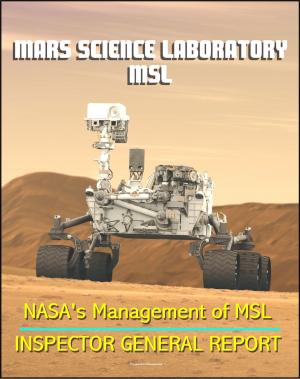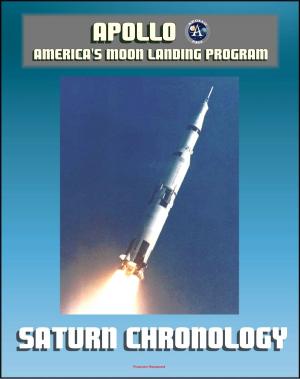Societal Impact of Spaceflight: Apollo, Shuttle, China, Russia, Reconnaissance, GPS, Earth Satellites, JPL, Food Standards, Spacefaring Species (NASA SP-2007-4801)
Nonfiction, Science & Nature, Science, Physics, Astrophysics & Space Science| Author: | Progressive Management | ISBN: | 9781465839992 |
| Publisher: | Progressive Management | Publication: | February 7, 2012 |
| Imprint: | Smashwords Edition | Language: | English |
| Author: | Progressive Management |
| ISBN: | 9781465839992 |
| Publisher: | Progressive Management |
| Publication: | February 7, 2012 |
| Imprint: | Smashwords Edition |
| Language: | English |
This official NASA history document - converted for accurate flowing-text ebook format reproduction - contains thirty-three essays by noted experts on the societal impact of spaceflight.
Contents: Chapter 1 - Has Spaceflight Had an Impact on Society? An Interpretative Framework * Chapter 2 - What Are Turning Points in History, and What Were They for the Space Age? * Chapter 3 - In Search of a Red Cosmos: Space Exploration, Public Culture, and Soviet Society * Chapter 4 - Live from the Moon: The Societal Impact of Apollo * Chapter 5 - Framing the Meanings of Spaceflight in the Shuttle Era * Chapter 6 - Space in the Post-Cold War Environment * Chapter 7 - The Taikonaut as Icon: the Cultural and Political Significance of Yang Liwei, China's First Space Traveler * Chapter 8 - Commercial and Economic Impact of Spaceflight: An Overview * Chapter 9 - The Political Economy of Spaceflight * Chapter 10 - The Role of Space Development in Globalization * Chapter 11 - NASA as an Instrument of U.S. Foreign Policy * Chapter 12 - "From Farm to Fork": How Space Food Standards Impacted the Food Industry and Changed Food Safety Standards * Chapter 13 - The Social and Economic Impact of Earth Observing Satellites * Chapter 14 - Satellites and Security: Space in Service to Humanity * Chapter 15 - For All Mankind: Societal Impact of Application Satellites * Chapter 16 - NASA and the Environment: Science in a Political Context * Chapter 17 - NAVSTAR, the Global Positioning System: A Sampling of Its Military, Civil, and Commercial Impact * Chapter 18 - Dual-Use as Unintended Policy Driver: The American Bubble * Chapter 19 - Reconnaissance Satellites, Intelligence, and National Security * Chapter 20 - Space History from the Bottom Up: Using Social History To Interpret the Societal Impact of Spaceflight * Chapter 21 - Space Science Education in the United States: The Good, the Bad, and the Ugly * Chapter 22 - "Racism, Sexism, and Space Ventures": Civil Rights at NASA in the Nixon Era and Beyond * Chapter 23 - NASA Launches Houston into Orbit: The Economic and Social Impact of the Space Agency on Southeast Texas, 1961—1969 * Chapter 24 - The Jet Propulsion Laboratory and Southern California * Chapter 25 - Overview: Ideology, Advocacy, and Spaceflight—Evolution of a Cultural Narrative * Chapter 26 - Spaceflight and Popular Culture * Chapter 27 - Making Spaceflight Modern: A Cultural History of the World's First Space Advocacy Group * Chapter 28 - C/SETI as Fiction: On James Gunn's The Listeners * Chapter 29 - Reclaiming the Future: Space Advocacy and the Idea of Progress * Chapter 30 - Space Activism as an Epiphanic Belief System * Chapter 31 - Flights of Fancy: Outer Space and the European Imagination, 1923-1969 * Chapter 32 - Are We a Spacefaring Species? Acknowledging Our Physical Fragility as a First Step to Transcending It * Chapter 33 - Production and Culture Together: Or, Space History and the Problem of Periodization in the Postwar Era
Fifty years after the Space Age began, it is time to examine the effects of spaceflight on society in a historically rigorous way. Has the Space Age indeed had a significant effect on society? If so, what are those influences? What do we mean by an "impact" on society? And what parts of society? Conversely, has society had any effect on spaceflight? What would be different had there been no Space Age? The purpose of this volume is to examine these and related questions through scholarly research, making use especially of the tools of the historian and the broader social sciences and humanities. Herein a stellar array of scholars does just that, and arrives at sometimes surprising conclusions. Once contemplated, the subject is broad, rich and stimulating. Spaceflight has commercial and economic dimensions, as well as social, cultural, and ideological ramifications. It touches on enduring American values of pioneering, progress, enterprise, and rugged individualism.
This official NASA history document - converted for accurate flowing-text ebook format reproduction - contains thirty-three essays by noted experts on the societal impact of spaceflight.
Contents: Chapter 1 - Has Spaceflight Had an Impact on Society? An Interpretative Framework * Chapter 2 - What Are Turning Points in History, and What Were They for the Space Age? * Chapter 3 - In Search of a Red Cosmos: Space Exploration, Public Culture, and Soviet Society * Chapter 4 - Live from the Moon: The Societal Impact of Apollo * Chapter 5 - Framing the Meanings of Spaceflight in the Shuttle Era * Chapter 6 - Space in the Post-Cold War Environment * Chapter 7 - The Taikonaut as Icon: the Cultural and Political Significance of Yang Liwei, China's First Space Traveler * Chapter 8 - Commercial and Economic Impact of Spaceflight: An Overview * Chapter 9 - The Political Economy of Spaceflight * Chapter 10 - The Role of Space Development in Globalization * Chapter 11 - NASA as an Instrument of U.S. Foreign Policy * Chapter 12 - "From Farm to Fork": How Space Food Standards Impacted the Food Industry and Changed Food Safety Standards * Chapter 13 - The Social and Economic Impact of Earth Observing Satellites * Chapter 14 - Satellites and Security: Space in Service to Humanity * Chapter 15 - For All Mankind: Societal Impact of Application Satellites * Chapter 16 - NASA and the Environment: Science in a Political Context * Chapter 17 - NAVSTAR, the Global Positioning System: A Sampling of Its Military, Civil, and Commercial Impact * Chapter 18 - Dual-Use as Unintended Policy Driver: The American Bubble * Chapter 19 - Reconnaissance Satellites, Intelligence, and National Security * Chapter 20 - Space History from the Bottom Up: Using Social History To Interpret the Societal Impact of Spaceflight * Chapter 21 - Space Science Education in the United States: The Good, the Bad, and the Ugly * Chapter 22 - "Racism, Sexism, and Space Ventures": Civil Rights at NASA in the Nixon Era and Beyond * Chapter 23 - NASA Launches Houston into Orbit: The Economic and Social Impact of the Space Agency on Southeast Texas, 1961—1969 * Chapter 24 - The Jet Propulsion Laboratory and Southern California * Chapter 25 - Overview: Ideology, Advocacy, and Spaceflight—Evolution of a Cultural Narrative * Chapter 26 - Spaceflight and Popular Culture * Chapter 27 - Making Spaceflight Modern: A Cultural History of the World's First Space Advocacy Group * Chapter 28 - C/SETI as Fiction: On James Gunn's The Listeners * Chapter 29 - Reclaiming the Future: Space Advocacy and the Idea of Progress * Chapter 30 - Space Activism as an Epiphanic Belief System * Chapter 31 - Flights of Fancy: Outer Space and the European Imagination, 1923-1969 * Chapter 32 - Are We a Spacefaring Species? Acknowledging Our Physical Fragility as a First Step to Transcending It * Chapter 33 - Production and Culture Together: Or, Space History and the Problem of Periodization in the Postwar Era
Fifty years after the Space Age began, it is time to examine the effects of spaceflight on society in a historically rigorous way. Has the Space Age indeed had a significant effect on society? If so, what are those influences? What do we mean by an "impact" on society? And what parts of society? Conversely, has society had any effect on spaceflight? What would be different had there been no Space Age? The purpose of this volume is to examine these and related questions through scholarly research, making use especially of the tools of the historian and the broader social sciences and humanities. Herein a stellar array of scholars does just that, and arrives at sometimes surprising conclusions. Once contemplated, the subject is broad, rich and stimulating. Spaceflight has commercial and economic dimensions, as well as social, cultural, and ideological ramifications. It touches on enduring American values of pioneering, progress, enterprise, and rugged individualism.















